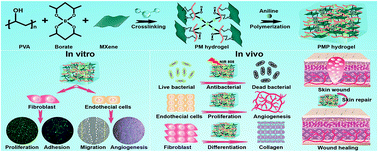Flexible, high-strength and multifunctional polyvinyl alcohol/MXene/polyaniline hydrogel enhancing skin wound healing†
Abstract
Nature-inspired flexible and multifunctional hydrogels are ideal materials for tissue repair. High-strength, wear-resistant, antibacterial and conductive hydrogels can potentially be applied in skin healing. However, their use is often hindered by problems including poor mechanical properties and conductivity. Herein, high-strength and conductivity and antibacterial polyvinyl alcohol (PVA) hydrogels with Ti3C2Tx (MXene) and polyaniline (PANI) have been developed to enhance skin wound healing. MXene strengthens the hydrogen bonds between PVA molecules and provides antibacterial ability lighted by near-infrared (NIR). PANI acts as an electric conductor and forms chemical bonds via polymerization with PVA to further enhance the mechanical properties of hydrogels. The PVA/MXene/PANI (PMP) hydrogels exhibit excellent mechanical properties (with a tensile strength of 4.1 MPa and a fracture energy of 130 kJ m−2), high electrical conductivity (0.22 S m−1) and antibacterial ability. The hydrogels significantly inhibit bacterial activity in vitro and vivo. Meanwhile, the hydrogels promote proliferation and enhance the migration of cells by electrical stimulation (ES). In addition, PMP hydrogels obviously accelerate skin wound healing by promoting angiogenesis and collagen deposition. Therefore, PMP multifunctional hydrogels are a prospective wearproof material for wound-healing dressings.



 Please wait while we load your content...
Please wait while we load your content...